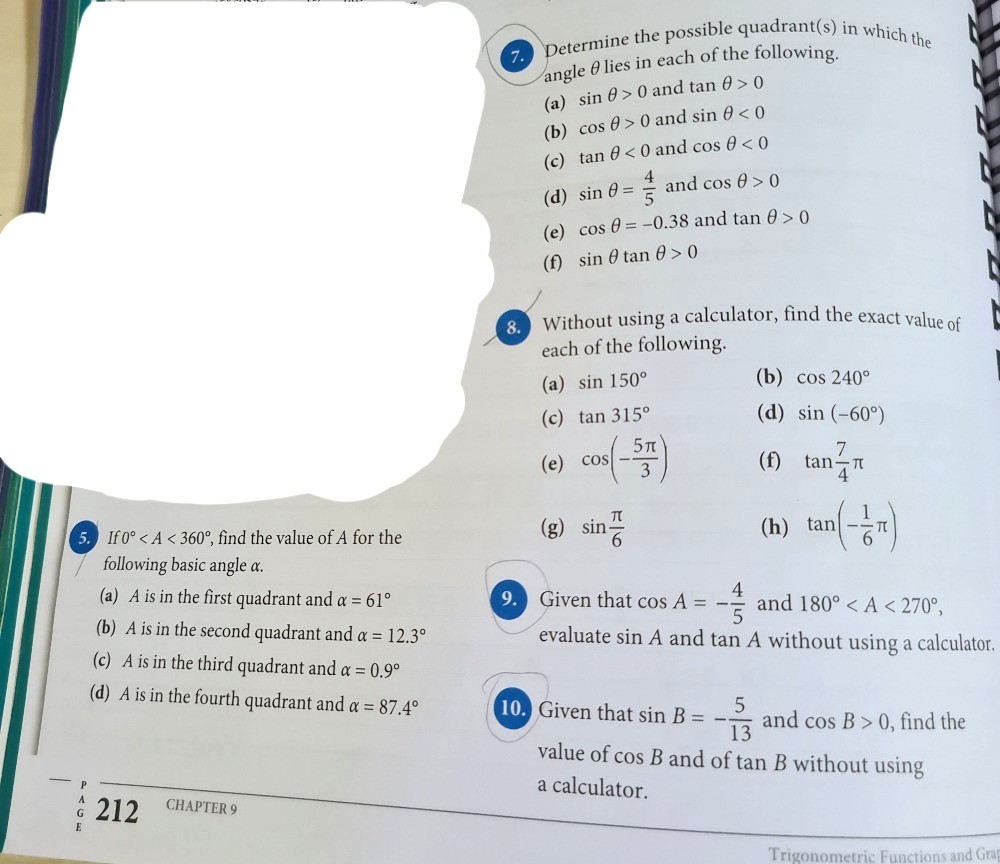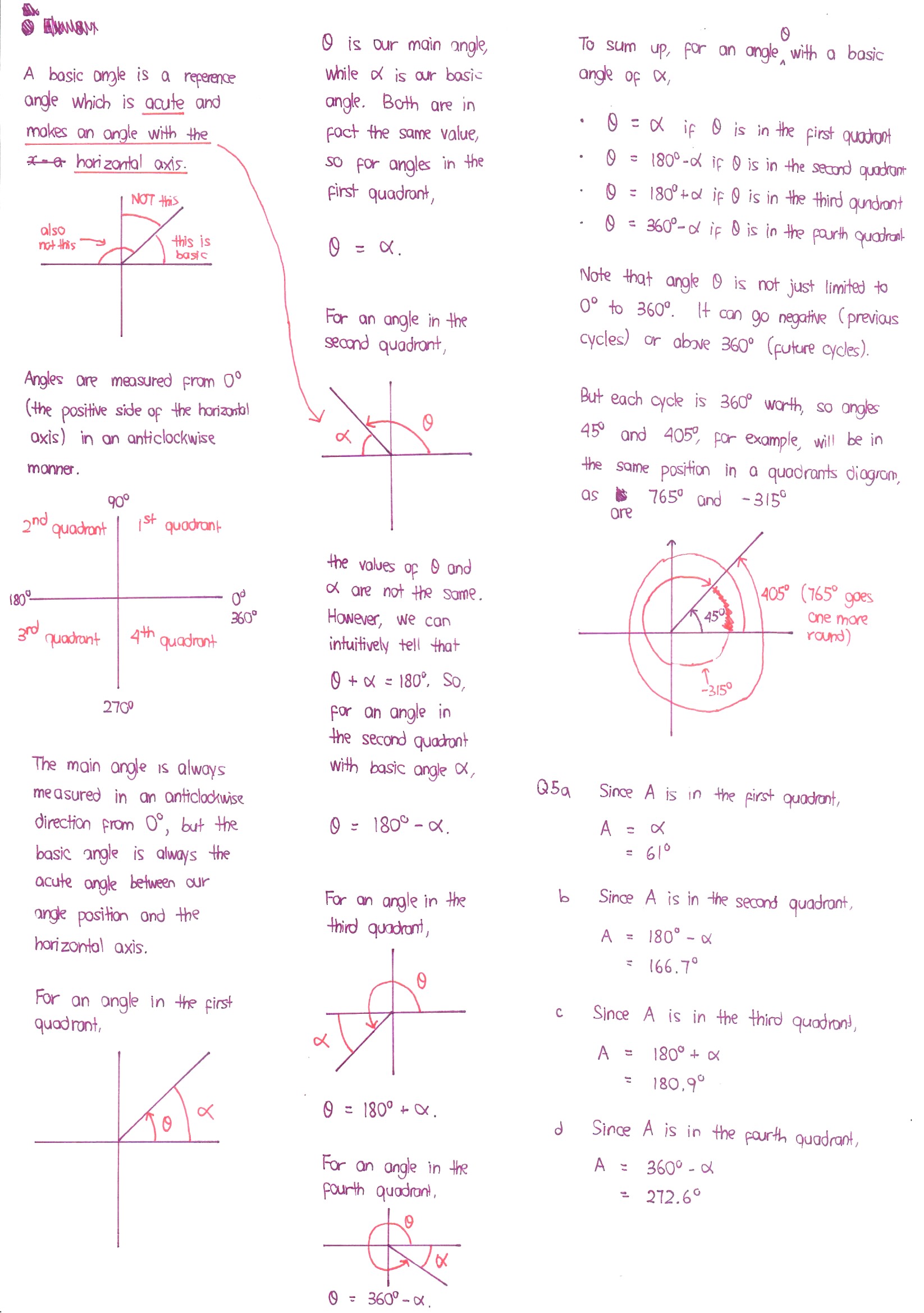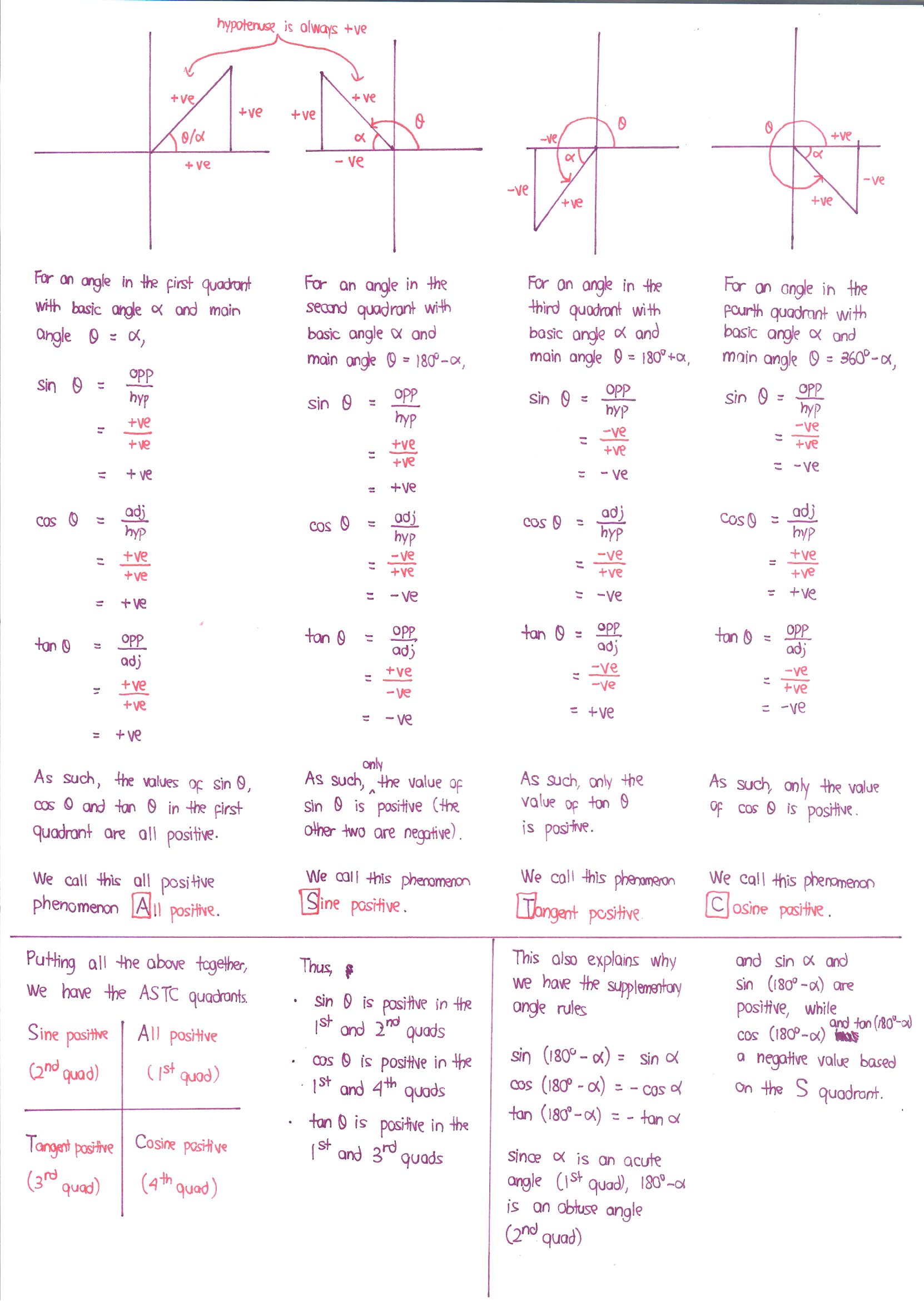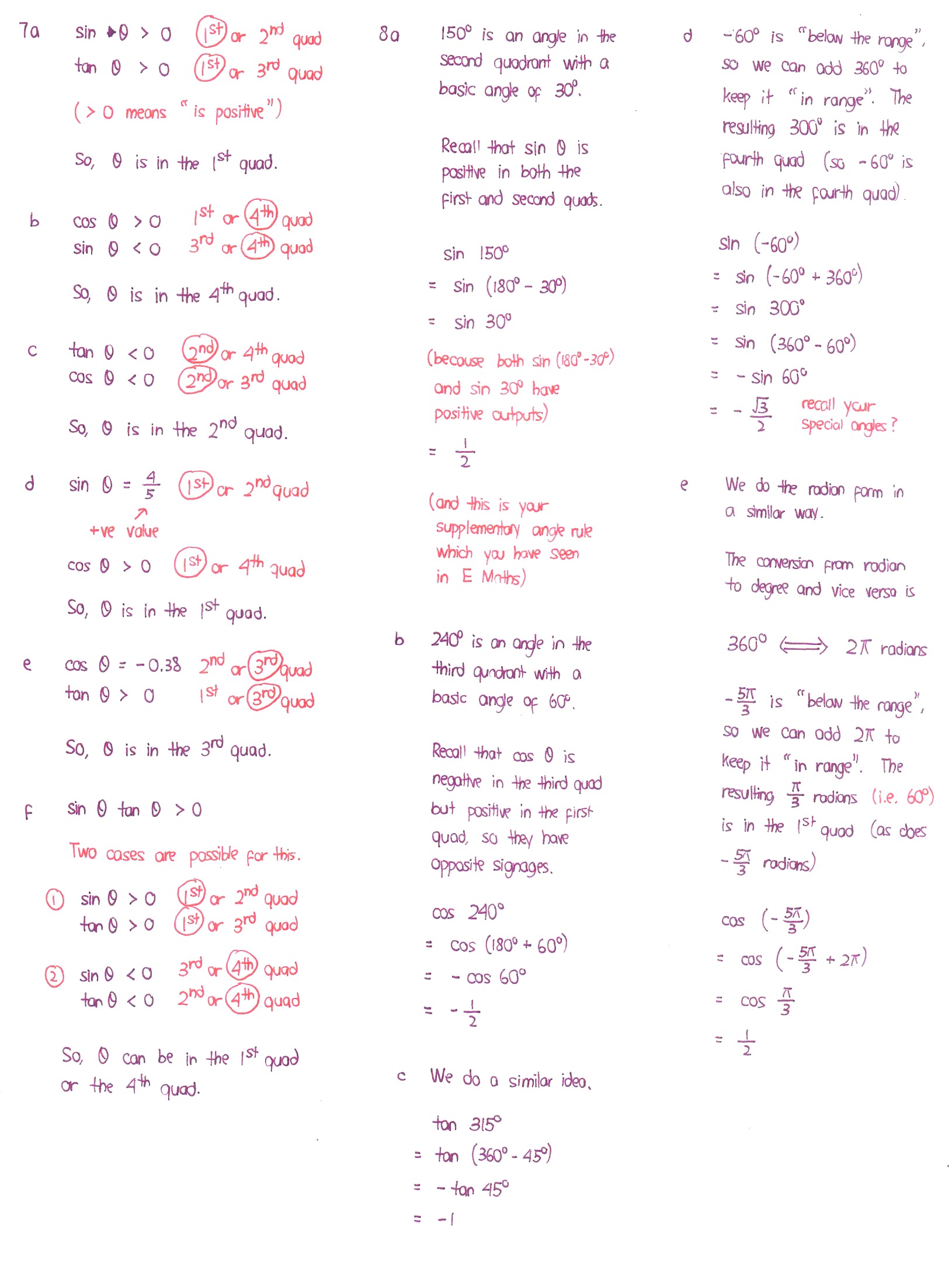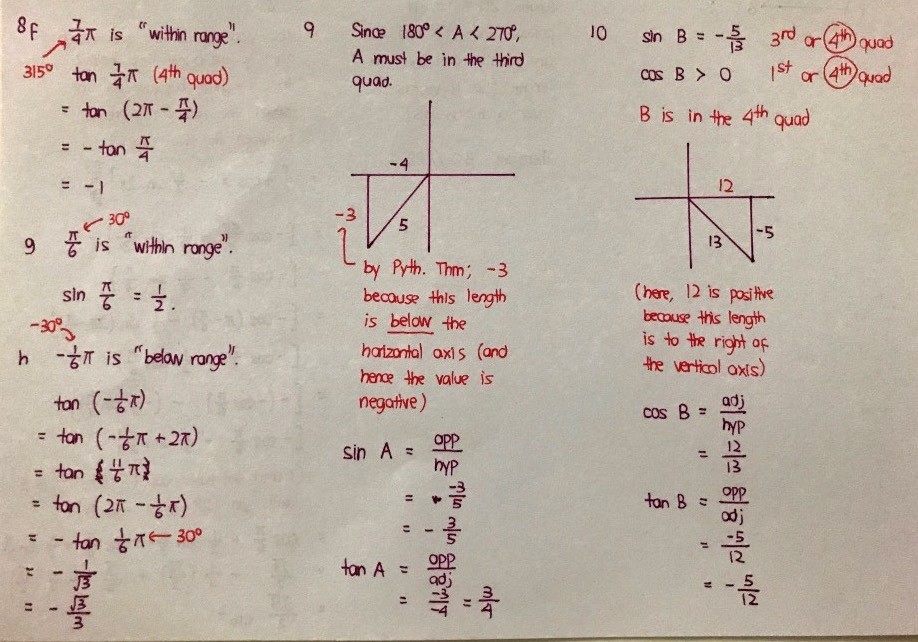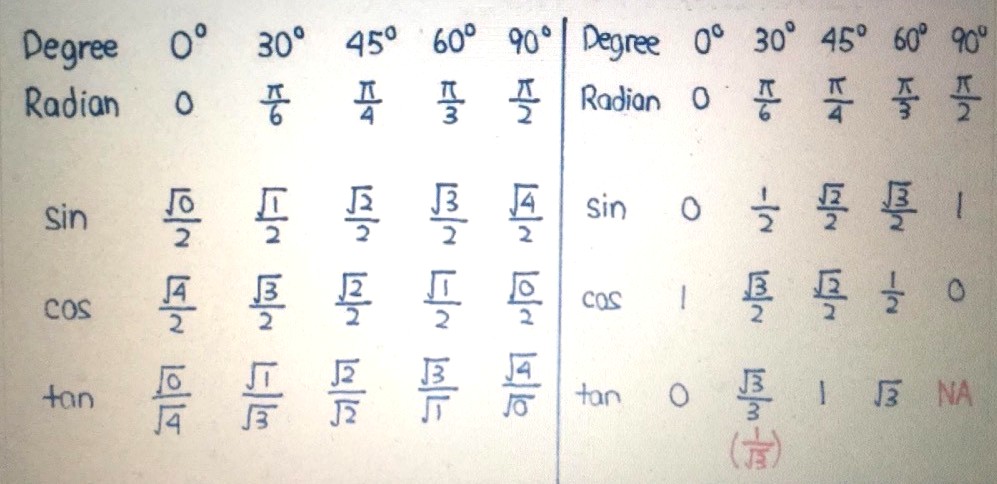Ask Singapore Homework?
Upload a photo of a Singapore homework and someone will email you the solution for free.

Question
secondary 3 | A Maths
5 Answers Below
Anyone can contribute an answer, even non-tutors.

need help with these qns, pls explain too:)
im very confused with this topic
Seems like your school has gone through this and it’s earlier than a lot of other schools.
If no one responds by perhaps 2 am, and I can remember, I explain to you the approach to do this.
Mr Eric can you explain to me about this topic too as i dont really know what my teacher is teaching? would really appreciate it :)
See 5 Answers
like 4th quadrant will be 1st quadrant for negative angle, 3rd quadrant will be 2nd and so on
Angles beyond 360 degrees have similar ideas. 360 degrees to 450 degrees is the first quadrant, 450 degrees to 540 degrees is the second quadrant and so on.
When an angle is out of range, we can keep adding 360 degrees (if the angle is below range) or subtracting 360 degrees (if the angle is above range) until we reach an angle between 0 degrees and 360 degrees. This causes our angle to return to the main cycle 0 degrees to 360 degrees whilst keeping our angle position at the same point within our diagram.
So if you have an angle of 1485 degrees, for example, we subtract 360 degrees four times in a row to attain 45 degrees, and then we can say that
tan 1485 deg
= tan 45 deg
= 1
also have a question on the radian one
0 to 90 is acute, 90 to 180 is obtuse and 180 to 360 is reflex.
Angles are, however, not actually bounded to this "0 to 360" interval. Angles actually exist below 0 degrees and above 360 degrees, which are out of the regular range of 0 to 360. Well, we can't think of a physical shape which produces a single angle beyond 360, but the ideas of angles beyond 360 do exist.
A quadrants angle is designed to contain angles in a 360 degrees interval, The angle at which the angle points towards is the angle of interest. It's like bearings, but different.
Beyond 360 degrees, however, the angles are going to repeat another round of the same old directions. An angle of, say. 400 degrees, is basically an angle which has undergone a full 360 degrees rotation before going a further 40 degrees. In the quadrants diagram, the angle 400 degrees will be in the exact same position as an angle of 40 degrees, although it is spaced apart by one full cycle.
If you go one more round to 760 degrees, it will return to the same position.
So, for angles out of range, we must bring them back to within range by rotating them 360 degrees continuously until they fall within range. In computation, we just simply add 360 or subtract 360 continuously until we meet the desired angle.
sin (180 - x) = sin x
cos (180 - x) = - cos x
tan (180 - x) = - tan x
which you learnt just one or two weeks ago.
sin x times tan x can yield a positive value when
- sin x and tan x are both positive, OR
- sin x and tan x are both negative (because multiplying two negative numbers together gets us a positive number).
the equations stated in my textbook for the "relationship between......" thing is confusing
the equations stated in my textbook for the "relationship between......" thing is confusing"
-------------------------------------------------------
The trigo stuff in E Maths only covers angles from 0 to 180. It does not cover angles which are below 0 or above 180 because the trigo in E Maths only deals with the calculations of lengths and angles inside triangles.
So, what you have learnt in E Maths is only up to the supplementary angle rule,
sin (180 - x) = sin x
cos (180 - x) = - cos x
tan (180 - x) = - tan x
There are more formulae than this actually. Collecting our results from the ASTC quadrants, we can deduce these formulae as well.
sin (360 - x) = - sin x
cos (360 - x) = cos x
tan (360 - x) = - tan x
But as we know by now, if we reverse the angle 360 - x by 360 degrees, we get an angle -x which is in the same position as 360 - x. So, in the above formulae, the sine, cosine and tangent of -x is treated to be the same as the sine, cosine and tangent of (360 - x), simply because -x and 360 - x are in identical positions. Simplifying the above,
sin (-x) = - sin x
cos (-x) = cos x
tan (-x) = - tan x
There are many more formulae you will encounter in A Maths trigo.
For a unit circle of radius 1 unit, you will notice that the circumference of the circle is 2pi x 1 = 2pi units. So, if a point lies on the circle, it will have travelled 2pi units before returning to the same point. The point would have covered an equivalent angle of rotation of 360 degrees.
Hence, we can relate this equivalence, in angle terms, as
2pi radians <====> 360 degrees
Simplifying,
pi radians <====> 180 degrees
To convert from degrees to radians, we divide the degree angle by 180, then multiply a pi to it.
To convert from radians to degrees, we multiply our angle by 180, then divide by pi. If pi was already present in the radian form, we simply remove the pi at the end.
So, for example, pi/2 radians translate to 90 degrees, while pi/6 radians translate to 30 degrees. Similarly, 450 degrees translate to 5pi/2 radians, while -45 degrees translate to -pi/4 radians.
You can try translating the following to the equivalent other form.
1. 270 degrees
2. 120 degrees
3. 720 degrees
4. -10 degrees
5. pi/9 radians
6. 2pi/5 radians
7. 10pi radians
8. 2 radians
Your calculator has a radian form as well, and you can convert between forms as well. If you are using Casio fx 96 SG Plus, you can press SHIFT —> MODE/SET UP. You will see a selection 3: Deg and 4: Rad. Selecting 3 will set your calculator to degree form, while selecting 4 will set your calculator to radian form. It is important to know what form your angles in each question take, because the modes will affect the computation of sin, cos and tan.
For example, the equivalent of 180 degrees is pi. If you type sin 180 when your calculator is in degree form, you will get an answer of 0. If you type sin pi when your calculator is in radian form, you will get an answer of 0. However, if you type sin 180 when your calculator is in radian form, or sin pi while your calculator is in degree form, you will get an incorrect answer. So, you will need to choose the correct settings for your calculator.
for example i will get 7.85...... instead of 5pi/2
is there a way to get the answer in radian form?
s = r theta,
is a formula for calculating the length of a circular arc when the angle used is in radian form. Its equivalent format in the degree form is
s = theta/360 times 2pi r, which is basically an angle proportion of the entire circumference of a circle. So, if you chop off a circle into two equal parts, you will expect the arc length of each portion to equal pi r units long.
In radian form, 180 degrees is equivalent to pi radians. With a radius r units, the arc length is s = r theta, or r times pi, which is the same as the degree form.
You will need to master this radian form of the angle as it is very frequently used in A Maths.
for example i will get 7.85...... instead of 5pi/2
is there a way to get the answer in radian form?"
------------------------------------
That is a good question. Some newer models of calculators are able to express a value as 2 pi, for example, whereas most calculators will only provide the decimal form.
One way to overcome this is to avoid the use of pi as we enter the values into the calculator. For example, converting 720 degrees to radians gives us 4 pi radians. The conversion requires us to multiply the degree version by pi/180 to get the radian form; however, in practice, we just key in 720 x 1/180 rather than 720 x pi/180 to get a value of 4 before we manually multiply the value by pi to get 4pi. This is to avoid seeing decimals due to the 4pi expression.
Another way is to familiarise yourself with common decimals for values of pi, especially pi, 2pi, pi/2, pi/3, pi/4 and pi/6.
btw do we always have to add 2pi to the value if the value is below range?
eg 2nd quadrant pi- value
3rd quadrant pi + value
or is it another type of eqn used here for the 2pi-....
Then the usual rules apply for the quadrant
If your angle is in the first quadrant, then it is related to basic angle by x = alpha.
If second quadrant, x = 180 - alpha.
If third quadrant, x = 180 + alpha.
If fourth quadrant, x = 360 - alpha.
1575 is 3 x 360 + 135.
So, 1575 is in the same position as 135 which lies in the second quadrant and has a basic angle of 45.
sin 1575
= sin (4 x 360 + 135)
= sin 135
= sin 45 (since sine in the second quadrant is also positive just like sin 45)
= 0.5 times ./2

